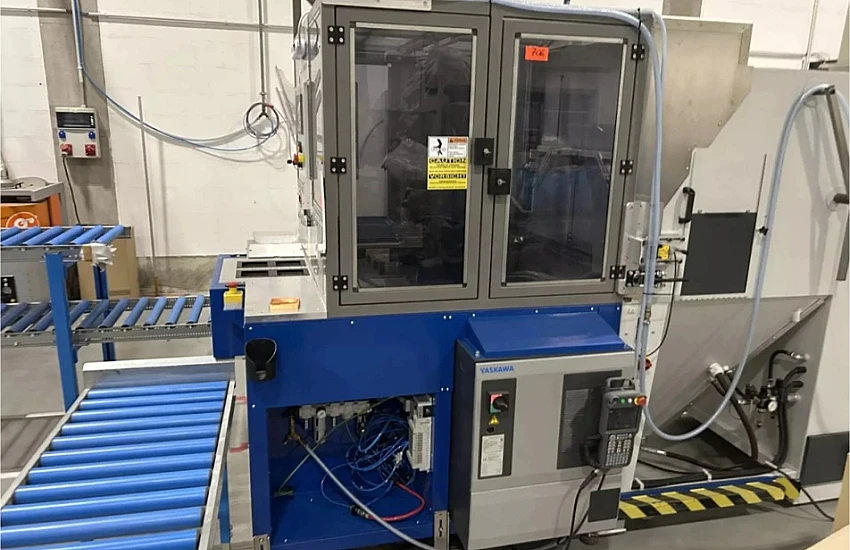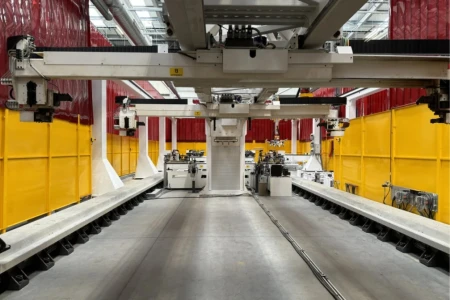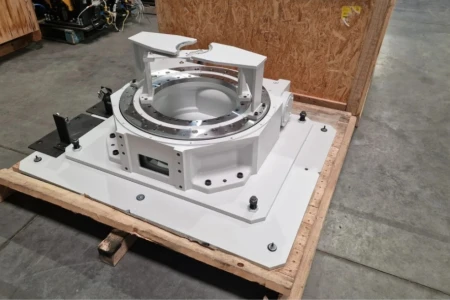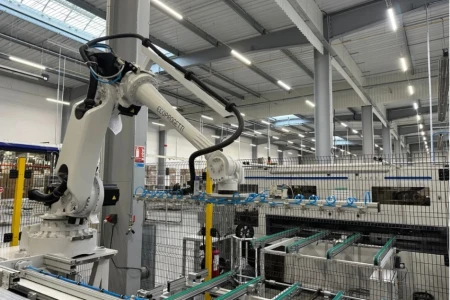Table of Contents
In this article, we present the key features of the automated cabin, the advantages of using the YASKAWA grinding robot and the main areas of its use. Learn how the satin finishing system can increase the efficiency of your company and raise the standards of metal surface treatment.
1. Introduction
What is metal satinizing?
Satinizing is a metal surface treatment process that gives it a delicate, matte structure with a uniform appearance. It is a method often used to improve the aesthetics and functionality of metal details. Unlike polishing, which gives the surface a high gloss, satinizing allows for a subtle visual effect, reducing light reflections and traces of use. The modern satinizing system guarantees high quality and repeatability of processing.
2. Key functions and advantages
The SAPI Büffel 100 satinizing booth and the YASKAWA robot are distinguished by a number of innovative functions that allow for the optimization of the satinizing process and increase its efficiency.
Main functions of the cabin:
- Automatic satinizing system - ensures even and precise processing of the entire surface of the element.
- Integrated dust removal system - effectively removes dust and impurities created in the metal grinding process.
- Possibility of integration with a YASKAWA robot - full production robotization for even greater accuracy and repeatability.
- Automated cabin – ergonomic design facilitates operation and increases efficiency.
- Modular construction – possibility of adapting the cabin configuration to specific production needs
Key advantages of use:
- Precise CNC machining – the cabin ensures uniform surface finish, eliminating the need for additional manual processing.
- Increased efficiency – the automated cabin allows for quick and effective automatic metal matting.
- Reduction of production costs – lower consumption of abrasive materials and elimination of human errors.
- Work safety – the closed cabin structure protects operators from dust and noise.
- Possibility of adjusting parameters – adjustment of speed, pressure force and type of abrasive depending on material requirements.
Why is the YASKAWA robot the ideal solution for satin finishing?
- The grinding robot provides precise control – controls the angle of the tool and the pressure force.
- Process repeatability – unlike manual processing, the robot performs the same movement with identical force and precision.
- Motion path programming – the ability to program different work patterns depending on the type of material being processed and the expected effect.
Benefits of using the YASKAWA robot in a satinizing booth:
- Production automation – the ability to work in 24/7 mode without interruptions.
- Better surface quality – even surface finish without streaks and unevenness.
- Operator safety – the automated booth eliminates the need for direct human contact with the processing process.
3. Technical specifications of the SAPI Büffel 100 satinizing booth and the YASKAWA robot
The SAPI Büffel 100 satinizing booth and the YASKAWA robot, available in our offer, constitute an efficient and precise satinizing system, designed for a wide range of applications.

Technical data of the SAPI Büffel 100 satinizing booth:
- Year of production: 2020
- Serial number: 20648

YASKAWA YR-1-06VX-A00 industrial robot
- Serial number: K18777-473-1
- Control: YASKAWA Eras-1000-06VX8- E10
4. Main applications of the SAPI Büffel 100 satinizing booth and the YASKAWA robot
The SAPI Büffel 100 satinizing booth in combination with the YASKAWA robot is widely used in many industries. Thanks to automation and precise control of the processing process, this system is used for satinizing, matting and grinding various types of metal details.
4.1 Metal and steel industry
One of the main sectors in which the SAPI Büffel 100 cabin is used is the metallurgical industry and metal processing.
Application in the production of steel and aluminum elements:
- Processing of stainless and acid-resistant sheets
- Satinizing of steel and aluminum profiles
- Matting of structural parts before further processing
- Surface preparation before anodizing and painting
4.2 Automotive industry
In the automotive sector, satinizing plays a key role in the production of body parts, exhaust systems and decorative details.
Most frequently processed elements in the automotive industry:
- Stainless steel elements (e.g. exhaust pipes)
- Aluminum strips and decorative accents
- Wheels and other aluminum parts
- Surfaces prepared for painting or electroplating
4.3 Production of architectural elements and interior design
In architecture and the production of metal furniture, satin finishing allows for a modern and elegant appearance of metal surfaces.
Typical applications in architecture and interior design:
- Stainless steel balustrades and handrails
- Decorative elements of building facades and elevations
- Handles, door handles and door fittings
- Steel structures in modern construction
4.4 Aerospace industry
The aerospace industry requires the highest precision in metal surface treatment, which makes SAPI Büffel 100 an excellent choice for satinizing aerospace components.
Applications in the aerospace industry:
- Machining of aluminum alloys used in aircraft structures
- Matting and surface preparation before anodizing
- Satinizing titanium structural elements
- Improving aerodynamics and reducing light reflections
5. Summary
The SAPI Büffel 100 satinizing cabin with a YASKAWA robot is a modern solution for companies dealing with precise metal surface treatment. Thanks to the use of an automatic satinizing system, integrated dust removal system and the possibility of full process robotization, the device ensures high quality, repeatability and efficiency of processing.
One of the important advantages of the system is the connection with the YASKAWA robot. It guarantees precise movement and better use of abrasive materials.
Thanks to this, the process is fully automated. This reduces human errors and increases production efficiency. The ability to program motion paths and adjust processing parameters makes the device universal and flexible in use.







